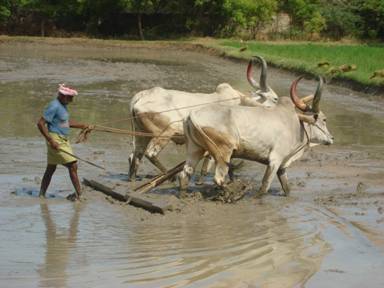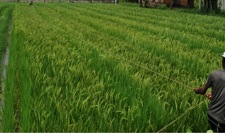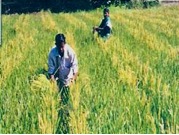QUALITY SEED PRODUCTION IN RICE HYBRIDS
Land requirement
Land should be free of volunteer plants. The previous crop should not be the other varieties of the same crop. It can be the same variety, if it is certified as per the procedures of certification agency.
Field standards
A. General requirements
Isolation
- Hybrid rice seed fields shall be isolated from the contaminants by allowing the isolation distance as specified below.
Contaminants
|
Minimum distance (meters) |
Foundation |
Certified |
Fields of other varieties including commercial hybrid of the same variety |
200 |
100 |
Fields of the same hybrid (code designation) not conforming to varietal purity requirements for certification |
200 |
100 |
- Time isolation : 25 days (later)
- Barrier isolation : Either a distance of 30 m with vegetative barrier or plastic sheet with 2 m height.
B. Specific requirements
Factor
|
Maximum permitted (%)* |
Foundation |
Certified |
Off-types in seed parent |
0.050 |
0.20 |
Off-types in pollinator |
0.050 |
0.20 |
Pollen shedding earheads in seed parent |
0.050 |
0.10 |
**Objectionable weed plants |
0.010 |
0.020 |
*Standards shall be met at any inspection conducted at and after flowering.
**Objectionable weed shall be: Wild rice (Oryza sativa L. var. fatua Prain) (Syn. O. sativa L.f. spontanea Rosch.) |

Land preparation
|
Staggered Sowing :
- Male parent should be sown in three to four staggered sowings based on the duration of parental lines for continuous availability of pollen till the completion of flowering in the female parent.
Spacing
- Between 'A' lines 10 cm; between 'R' lines 30 cm; between A and 'R' line 20 cm; between plants 15 cm.
Planting design
Planting ratio : 8:2 to 10:2 (Female : Male)
Plant @ 2-3 seedlings / hill
Border rows : 4 rows all around the field

Planting design for hybrid seed production in rice |
-
Fertilizer application
Apply NPK @ 150 : 60 : 60 kg / ha.
Apply N and K in 3 split doses during the basal, active tillering and panicle initiation
stages.
Field inspection
* A minimum of four inspections shall be made as follows
-
The first inspection shall be made before flowering in order to determine isolation, presence of volunteer plants, outcrosses, planting ratio, errors in planting and other relevant factors.
-
The second and third inspections shall be made during flowering to check isolation, off-types, pollen shedders in female parent and other relevant factors.
-
The fourth inspection shall be made at maturity and prior to harvesting to verify true nature of the plant and other relevant factors
Foliar application
- Foliar spray of 2 % DAP at boot leaf stage and another at 5 - 10 % flowering stage.
Special operations for panicle exertion
- Foliar spray of GA3 @ 75 g / ha in two split doses
- First dose at 5 - 10 % panicle emergence stage @ 40 g / ha followed by 35 g of GA3 at 24 h after first spray.
[Note: GA3 should be dissolved in 70 % ethyl alcohol.]
Supplementary pollination technique
|
|
Rope pulling and stick shaking in hybrid rice seed production field |
|
Harvesting
- Harvest the male parent (R line) first and remove completely from the field.
- Then harvest the seed parent (A line).
 |
| Harvesting seed parent |
|
Drying
- Sundry the seeds to reduce the moisture content to 12 - 13 %.
Grading
- For getting better seed quality, size grade the seeds using 1.3 mm x 19 mm oblong sieve.
- Size graded seeds may be upgraded by density grading using specific gravity separator.
- Heavy and medium fractions with 90 - 92% recovery are selected for seed purpose.
Pre-storage seed treatment
- Treat the seeds with carbendazim @ 2 g / kg.
- Treat the seeds with halogen mixture @ 3 g / kg (CaOCl2 + CaCO3 + arappu (Albizzia amara) leaf powder mixed in the ratio of 5:4:1) as eco-friendly treatment.
Storage
- Store the seeds in gunny or cloth bags for short term storage (8 - 9 months) with a seed moisture content of 12 - 13 %.
- Store the seeds in polylined gunny bag for medium term storage (12 - 15 months) with a seed moisture content of 8 - 9 %.
- Store the seeds in 700 gauge polythene bag for long term storage (more than 15 months) with a seed moisture content less than 8 %.
.
Seed standards
Factor
|
Standards for each class |
Foundation |
Certified |
Pure seed (minimum) |
98.0% |
98.0% |
Inert matter (maximum) |
2.0% |
2.0% |
Huskless seeds (maximum) |
2.0% |
2.0% |
Other crop seeds (maximum) |
10/kg |
20/kg |
Other distinguishable varieties (maximum) |
10/kg |
20/kg |
Total weed seeds (maximum) |
10/kg |
20/kg |
Objectionable weed seeds (maximum) |
2/kg |
5/kg |
Seeds infected by paddy bunt (Neovossia horrida (Tak.) Padwick & Azmatulla Khan) (maximum) |
0.10%
(by number) |
0.50%
(by number) |
Germination (minimum) |
80% |
80% |
Moisture (maximum) |
13.0% |
13.0% |
For vapour-proof containers (maximum) |
8.0% |
8.0% |
Source
The Professor and Head
Department of Seed Science & Technology
TNAU, Coimbatore-641003.
Phone:0422-6611363
Email: seed@tnau.ac.in
|





